![]()
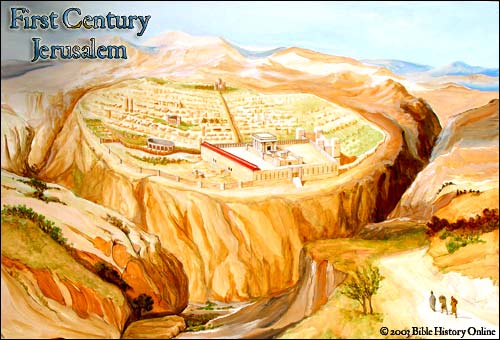
![]()
 Jerusalem�s Name.
The etymology of the name
Jerusalem
is not certain; it is apparently of Semitic origin. An Egyptian notice from the
third quarter of the nineteenth century B.C. mentions Urusalimum. The Assyrians
called it Ursalimmu. Modern scholars take these names to mean
"founded by the god Shalem,"
a god of the Amorites (Jerusalem is said to have been founded by Amorites and
Hittites; (Ezek 16:3,45).
Jerusalem�s Name.
The etymology of the name
Jerusalem
is not certain; it is apparently of Semitic origin. An Egyptian notice from the
third quarter of the nineteenth century B.C. mentions Urusalimum. The Assyrians
called it Ursalimmu. Modern scholars take these names to mean
"founded by the god Shalem,"
a god of the Amorites (Jerusalem is said to have been founded by Amorites and
Hittites; (Ezek 16:3,45).
In time, however, the second part of the name became associated with shalom ("peace") in Hebrew minds, and Jerusalem came to mean "city of peace." Romans and Greeks called it Hierosolyma. To the Arabs it is El Kuds, meaning "holy town."
The first city of Palestine, and the "holy city" for three great world religions: Christianity, Judaism, and Islam.
Jerusalem's Names (Jerusalem means "The City of Peace")
1. Salem was the first recorded name of Jerusalem revealed in the Scriptures. Jeru means city and the word "Salem" comes from the Hebrew 'Shalom" and means "Peace" but it means much more than peace, shalom has a connotation of wholeness, contentment, blessing, prosperity, and lack of aggression. Genesis 14 reveals that Melchizedek was the king of Salem when Abraham met him and paid him tithes from his spoils of the war against the kings of the east. David said, " In Salem is the tabernacle and his dwelling place in Zion " (Ps. 76:2).
2. Jebus was the second name and also mentioned in the Bible. It was an old name of Jerusalem derived from the Jebusites who dwelt there during the time of king David. During this period the city was really Mount Zion, the chief hill (Judg. 19: 10; 1 Chron. 11:4, 5). Note: Even though the Jebusites referred to Jerusalem as Jebus, the Tell El Amarna Tablets shed light on the etymology of the very ancient name using the name "Urusaliyim" for Jerusalem.
3. Jerusalem was a combination of Jebus and Salem and was first mentioned in the Bible in Joshua 10:1, where Adoni-zedek, king of Jerusalem, made an alliance with other kings against Joshua of Israel.
4. The City of David was the next name of Jerusalem mentioned in
Scripture. Once David became king over Israel he conquered the Jebusites and
stormed their fortress on Mount Zion (1 Sam. 5:5-9).Jerusalem became his home
and the capital of his kingdom. Jerusalem became the City of David.
5. Aelia Capitoiina was the next name given to Jerusalem. In 135 AD after the Roman had destroyed and buried the city they rebuilt a portion of the city and erected a temple to Jupiter on Mount Moriah and forbid access ti any Jew to enter Jerusalem. The Emperor Hadrian gave Jerusalem the name "Aelia Capitoiina" and the Moslems retained this name until the time of the Crusades.
6. El Khuds is the name given by the Mohammedans, and it is known by this name at the present time.
7. Jerusalem regained its name with the creation of the State and Country of Israel despite the fact that the Muslims control the Temple Mount.
Jerusalem�s Location. Jerusalem is located 14 miles west of the Dead Sea, 33 miles east of the Mediterranean. Bethlehem lies about 5 miles to the southeast. The city is situated on an uneven rocky plateau at an elevation of 2,550 feet. It is 3,800 feet above the level of the Dead Sea. It is poetically called "beautiful in elevation, the joy of the whole earth" (Ps 48:2). Its location has helped to give it prestige and protection.
Jerusalem stands at a point where three steep-sided little ravines join to form one valley. They are the Kidron, Tyropoeon, and Hinnom valleys. The Kidron runs north and south and lies on the east of the city. Between it and the Tyropoeon Valley (also north-south) a long, narrow spur extends southward; on this stood the Jebusite town conquered by David. Then a western hill (now known as Zion) stands between the Tyropoeon and the Hinnom, which runs north and south and then curves in an easterly direction to join the other two valleys. To the east of the Kidron rises the Mount of Olives.
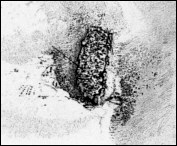
Jerusalem � David�s Time
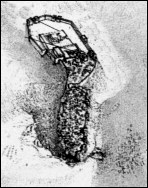
Jerusalem � Solomon�s Time
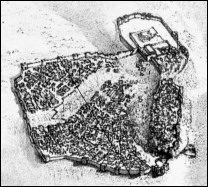
Jerusalem � Hezekiah�s Time
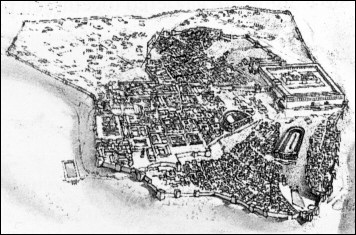
Jerusalem � Jesus�s Time
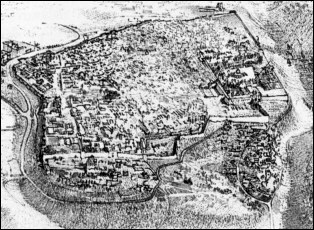
Jerusalem � Today
The Jerusalem of Herod the Great
The Jerusalem Jesus knew nowhere near resembled the city David conquered in the tenth century BC. At that time, it had been a small, isolated hill fortress, valued more for its location than its size or splendor. Yet from that time on it was known as the City of David, and the kings of David's dynasty, especially his son Solomon, had enlarged and beautified it.
In the sixth century BC, the army of Nebuchadnezzar leveled Jerusalem and drove its citizens into exile. During the long years of captivity in Babylon, the Jews in exiles' prayers and longings focused on the distant Holy City. But the city rebuilt by the Jews who returned a century later was far inferior to its former splendor. It was, ironically, the hated tyrant Herod the Great who restored Jerusalem to its former grandeur.
In the 33 years of his reign (37-4 B.C.), Herod transformed the city as had no other ruler since Solomon. Building palaces and citadels, a theatre and an amphitheatre, viaducts (bridges) and public monuments. These ambitious building projects, some completed long after his death, were part of the king's single-minded campaign to increase his capital's importance in the eyes of the Roman Empire.
No visitor seeing Jerusalem for the first time could fail to be impressed by its visual splendor. The long, difficult ascent from Jericho to the Holy City ended as the traveler rounded the Mount of Olives, and suddenly caught sight of a vista like few others in the world. Across the Kidron Valley, set among the surrounding hills, was Jerusalem, "the perfection of beauty," in the words of Lamentations, "the joy of all the world."
The view from the Mount of Olives was dominated by the gleaming, gold-embellished Temple which was located in the most holy spot in the Jewish world and really God's world. This was the Lord's earthly dwelling place, He mediated His throne here and raised up a people to perform rituals and ceremonies here that would foreshadow the coming of His Messiah kinsman redeemer who would be the lamb of God, slain for the sins of the whole world.
The Temple stood high above the old City of David, at the center of a gigantic white stone platform.
To the south of the temple was THE LOWER CITY, a group of limestone houses, yellow-brown colored from years of sun and wind. Narrow, unpaved streets and houses that sloped downward toward the Tyropean Valley, which ran through the center of Jerusalem.
Rising upward to the west was THE UPPER CITY, or Zion, where the white marble villas and palaces of the very rich stood out like patches of snow. Two large arched passageways spanned the valley, crossing from the Upper City to the temple.
A high, thick, gray stone wall encircled Jerusalem. It had been damaged, repaired and enlarged over the centuries, and in Jesus' day it was about 4 miles in circumference, bringing about 25,000 people into an area about a square mile. At intervals along the wall were massive gateways. Just inside each gate was a customs station, where publicans collected taxes on all goods entering or leaving the city.
Commerce of the Lower City
Once past one of the gates, you would face a maze of dusty streets and alleyways, running uphill and down in every direction. As you made your way toward the temple, you would hear sounds of voices, the clatter of hooves and odors of cooking food. Along the Small Market street in the Lower City, you would pass open-air shops where Jerusalem's craftsmen sat at work: the city's weavers, dyers, potters, bakers, tailors, carpenters and metalworkers. Farther along you would enter the colorful bazaar, where merchants sold fruits and vegetables, dried fish, sacrificial animals, clothes, perfumes and jewelry.
The market street was always crowded and busy, especially on Mondays and Thursdays, the main market days, when citizens and visitors came there to buy goods or souvenirs. Perishable goods were on sale every day. Only on the Sabbath was the street empty and quiet.
After traveling you could stop to rest at one of Jerusalem's many taverns or restaurants. There you could select from a menu offering fresh or salted fish, fried locusts, vegetables, soup, pastry and fruit. You could drink local wine or imported beer.
The farmers of Jerusalem, like their rural cousins, went out each morning to tend their crops. Most of them worked in the rich olive groves that covered the surrounding hillsides and provided the city's only major export.
Jerusalem's numerous craftsmen had for a long time been organized into professional groups and most of them worked in public shops. The members of each group lived in a cluster of houses in a particular section of the city and they usually had their own synagogue. In Jesus' time, there were at least 480 synagogues in Jerusalem.
Pomp of the Upper City
Most of Jerusalem's working people lived in the crowded, noisy precincts of the Lower City. Their one- and two-story houses stood packed closely together. In contrast, the broad fashionable avenues of the Upper City were laid out in an orderly grid pattern like the elegant cities of Greece and Rome. This part of Jerusalem was the home of the rich and powerful Jewish families and high-ranking Roman officials.
Comfortably removed from the rest of the population, they lived in spacious white marble mansions and palaces built around courtyards with elaborate gardens and pools. The magnificent royal palace of Herod the Great- later used by the Roman governor of Judea during his visits to Jerusalem-was situated in the uppermost northwest corner of the city.
Directly in front of the palace stood the Upper Market, with its Roman-style arcades along three sides and an open court for market booths in the center. Here were the shops of the dealers in luxury goods: the distillers of expensive oils and perfumes; the master tailors and silk merchants; the goldsmiths and silversmiths; the dealers in ivory, incense and precious stones. Household slaves went there to buy expensive imported foods for their masters' banquet tables.
Not far away was the PALACE OF THE HIGH PRIEST. (The high priest at the time of Jesus' ministry in Jerusalem, Caiaphas, did not live there but in another section of the Upper City. Jesus' trial before the Sanhedrin probably took place in one of the large halls of his palace). Herod the Great had also built a THEATRE in the Upper City. It was a large, open-air auditorium with semicircular rows of seats ascending from a central stage. Wealthy Jews came there to watch the best of Greek and Roman drama. Most traditional Jews, however, scorned this and other outgrowths of Greco-Roman culture as immoral.
Jerusalem During the Feasts
During these times the enormous crowd of pilgrims into the Holy City inflated its population of 25,000 to at least four or five times that number. This brought an important stimulus to the city's economy. Besides creating a huge demand for food, lodging and sacrificial animals, the incoming Jews were required to spend a tenth of their annual income (after taxes) within Jerusalem. This "second tithe" was in addition to the tithe they had to pay directly to the temple.
Many pilgrims found lodging in one of Jerusalem's inns or in private homes. Some of the foreign Jewish communities had built shelters for their citizens to use when they visited the Holy City. The Essenes and Pharisees also provided lodging for fellow members. But the vast majority stayed in tents outside the city or in private homes in the villages of Bethphage or Bethany, where Jesus and his disciples stayed during his last months of ministry.
The overcrowding and the excitement of the festivals frequently led to outbreaks of violence and anti-Roman rebellion. On more than one occasion the huge mass of pilgrims had been stirred up by zealous nationalists or would-be Messiahs. For this reason, the Roman governor made a point of being present during these occasions, and extra soldiers were stationed at strategic locations throughout the city.
Besides attracting large crowds of pilgrims three times a year, the temple provided a constant demand for supplies from local merchants. Its requirements provided the backbone of the city's economy, and some had become extremely rich by monopolizing the supplying of certain items. The wealthy family of Garmo, for example, had the exclusive right to bake the offertory loaves of bread for the temple. Other merchants wove the priestly vestments, supplied incense, carried wood for the altar fires and fashioned the sacred ornaments and golden vessels.
![]()
Read The Bible
- 1599 Geneva Bible (GNV)
- 21st Century King James Version (KJ21)
- American Standard Version (ASV)
- Amplified Bible (AMP)
- Amplified Bible, Classic Edition (AMPC)
- Authorized (King James) Version (AKJV)
- BRG Bible (BRG)
- Christian Standard Bible (CSB)
- Common English Bible (CEB)
- Complete Jewish Bible (CJB)
- Contemporary English Version (CEV)
- Darby Translation (DARBY)
- Disciples’ Literal New Testament (DLNT)
- Douay-Rheims 1899 American Edition (DRA)
- Easy-to-Read Version (ERV)
- English Standard Version (ESV)
- English Standard Version Anglicised (ESVUK)
- Evangelical Heritage Version (EHV)
- Expanded Bible (EXB)
- GOD’S WORD Translation (GW)
- Good News Translation (GNT)
- Holman Christian Standard Bible (HCSB)
- International Children’s Bible (ICB)
- International Standard Version (ISV)
- J.B. Phillips New Testament (PHILLIPS)
- Jubilee Bible 2000 (JUB)
- King James Version (KJV)
- Lexham English Bible (LEB)
- Living Bible (TLB)
- Modern English Version (MEV)
- Mounce Reverse Interlinear New Testament (MOUNCE)
- Names of God Bible (NOG)
- New American Bible (Revised Edition) (NABRE)
- New American Standard Bible (NASB)
- New American Standard Bible 1995 (NASB1995)
- New Catholic Bible (NCB)
- New Century Version (NCV)
- New English Translation (NET)
- New International Reader's Version (NIRV)
- New International Version - UK (NIVUK)
- New International Version (NIV)
- New King James Version (NKJV)
- New Life Version (NLV)
- New Living Translation (NLT)
- New Matthew Bible (NMB)
- New Revised Standard Version (NRSV)
- New Revised Standard Version Catholic Edition (NRSVCE)
- New Revised Standard Version, Anglicised (NRSVA)
- New Revised Standard Version, Anglicised Catholic Edition (NRSVACE)
- New Testament for Everyone (NTE)
- Orthodox Jewish Bible (OJB)
- Revised Geneva Translation (RGT)
- Revised Standard Version (RSV)
- Revised Standard Version Catholic Edition (RSVCE)
- The Message (MSG)
- The Voice (VOICE)
- Tree of Life Version (TLV)
- World English Bible (WEB)
- Worldwide English (New Testament) (WE)
- Wycliffe Bible (WYC)
- Young's Literal Translation (YLT)
Table of Contents
Main Menu
- Ancient Assyrian Social Structure
- Ancient Babylonia
- Ancient Canaan During the Time of Joshua
- Ancient History Timeline
- Ancient Oil Lamps
- Antonia Fortress
- Archaeology of Ancient Assyria
- Assyria and Bible Prophecy
- Augustus Caesar
- Background Bible Study
- Bible
- Biblical Geography
- Fallen Empires - Archaeological Discoveries and the Bible
- First Century Jerusalem
- Glossary of Latin Words
- Herod Agrippa I
- Herod Antipas
- Herod the Great
- Herod's Temple
- High Priest's in New Testament Times
- Jewish Literature in New Testament Times
- Library collection
- Map of David's Kingdom
- Map of the Divided Kingdom - Israel and Judah
- Map of the Ministry of Jesus
- Matthew Henry Bible Commentary
- Messianic Prophecy
- Nero Caesar Emperor
- Online Bible Maps
- Paul's First Missionary Journey
- Paul's Second Missionary Journey
- Paul's Third Missionary Journey
- Pontius Pilate
- Questions About the Ancient World
- Tabernacle of Ancient Israel
- Tax Collectors in New Testament Times
- The Babylonian Captivity
- The Black Obelisk of Shalmaneser
- The Books of the New Testament
- The Court of the Gentiles
- The Court of the Women in the Temple
- The Destruction of Israel
- The Fall of Judah with Map
- The History Of Rome
- The Incredible Bible
- The Jewish Calendar in Ancient Hebrew History
- The Life of Jesus in Chronological Order
- The Life of Jesus in Harmony
- The Names of God
- The New Testament
- The Old Testament
- The Passion of the Christ
- The Pharisees
- The Sacred Year of Israel in New Testament Times
- The Samaritans
- The Scribes
Ancient Questions
- Why Do the Huldah Gates Appear Different in Ancient Replicas and Modern Photos?
- What Is the Origin of the Japanese and Chinese Peoples? A Biblical Perspective
- How did the ancient Greeks and Romans practice medicine and treat illnesses?
- What were the major contributions of ancient Babylon to mathematics and astronomy?
- How did the ancient Persians create and administer their vast empire?
- What were the cultural and artistic achievements of ancient India, particularly during the Gupta Empire?
- How did ancient civilizations like the Incas and Aztecs build their remarkable cities and structures?
- What were the major trade routes and trading practices of the ancient world?
- What was the role of slavery in ancient societies like Rome and Greece?
- How did the ancient Mayans develop their sophisticated calendar system?
Bible Study Questions
- Why Do Christians Celebrate Christmas?
- How Many Chapters Are There in the Bible?
- The Five Key Visions in the New Testament
- The 400-Year Prophecy: Unpacking Genesis 15 and the Journey of a People
- The Authorized (King James) Version (AKJV): Historical Significance, Translation Methodology, and Lasting Impact
- Exploring the English Standard Version (ESV): Its Aspects, Comparisons, Impact on Biblical Studies, and Church Use
- A Detailed Historical Analysis of Language Updates in the KJ21: Comparison with Other Versions
- A Detailed Historical Analysis of the American Standard Version (ASV): Comparison to the King James Version, Influence on Later Translations, and Evaluation of Strengths and Weaknesses
- A Detailed Historical Analysis of Amplifications in the Amplified Bible (AMP) and Its Comparison to Other Bible Translations
- Detailed Historical Analysis of the Amplified Bible Classic Edition (AMPC): Examples of Amplifications and Comparative Analysis with Other Bible Translations
About
Welcome to Free Bible: Unearthing the Past, Illuminating the Present! Step into a world where ancient history and biblical narratives intertwine, inviting you to explore the rich tapestry of human civilization.
Discover the captivating stories of forgotten empires, delve into the customs and cultures of our ancestors, and witness the remarkable findings unearthed by dedicated archaeologists.
Immerse yourself in a treasure trove of knowledge, where the past comes alive and illuminates our understanding of the present.
Join us on this extraordinary journey through time, where curiosity is rewarded and ancient mysteries await your exploration.
Recent posts
-

Prayers for Prophets: A Reflection on Reverence and Intercession
Prophets hold a revered status across many of the world’s major religions. As individuals chosen to convey divine messages, they are often remembere... -

How Machine Learning is Reducing Risk in Automated Trading
In today’s fast-paced monetary markets, automated buying and selling has come to be a cornerstone of current making an investment. Algorithms now ex... -

Timur Turlov: Driving Global Investment Innovation Through Freedom Holding Corp.
Timur Turlov leads Freedom Holding Corp. (NASDAQ: FRHC) as its CEO where he connects technology with finance and global markets. Turlov established Fr... -

AI in the Legal Industry: Can Algorithms Replace Lawyers?
The legal career is historically considered as a discipline rooted in human judgment, nuance, and vital questioning. But in recent years, Artificial I... -

Best Clothing Flipping Examples
Clothing flipping has become an increasingly popular way to make extra income, with many entrepreneurs turning it into a full-time business. The conce...